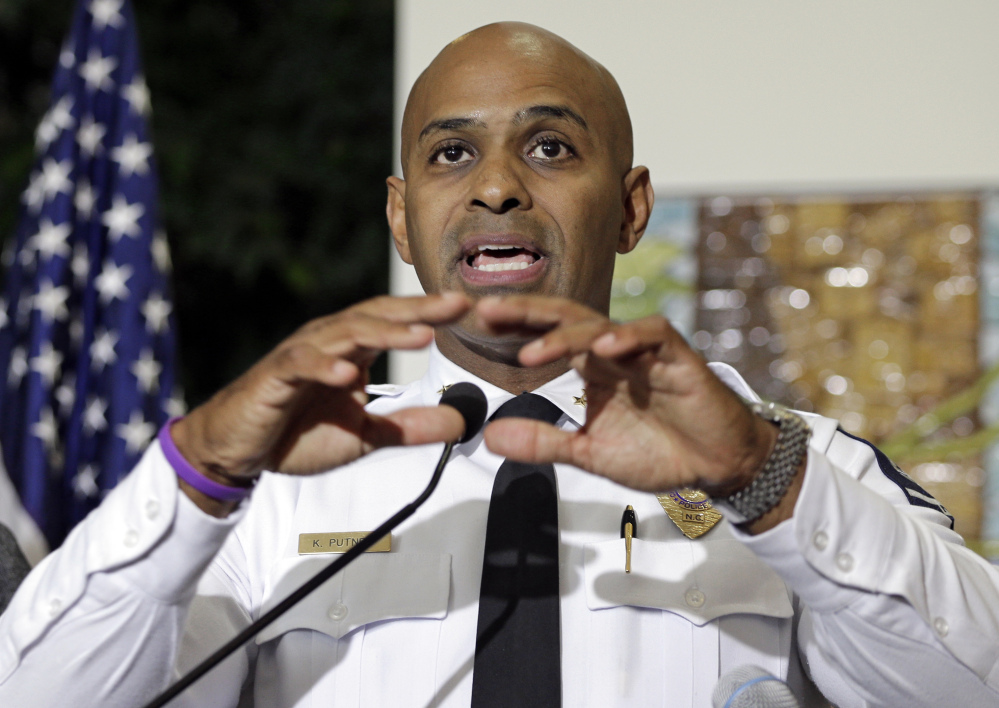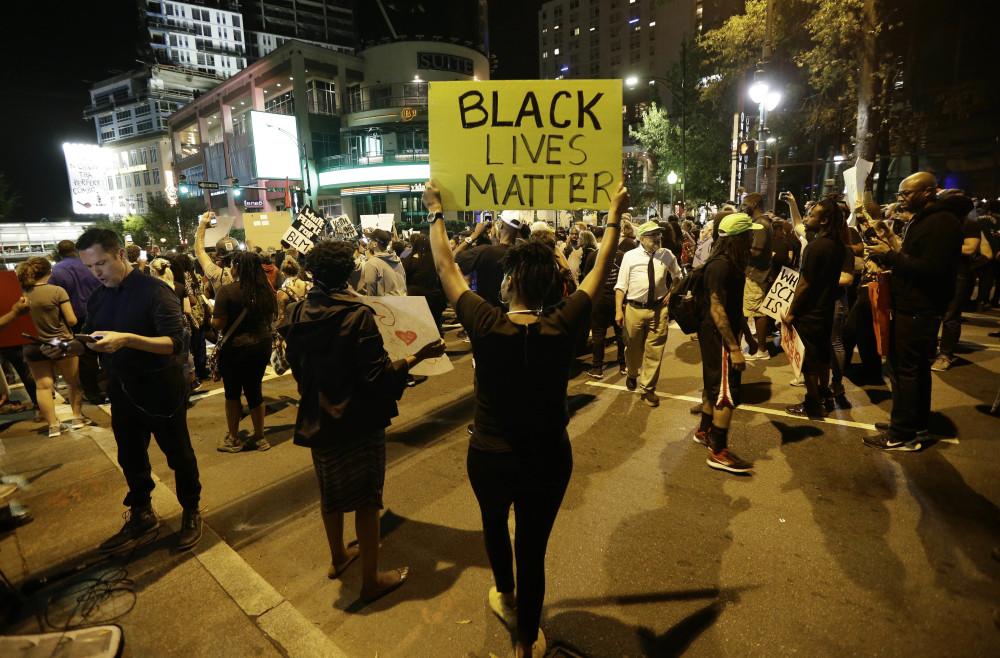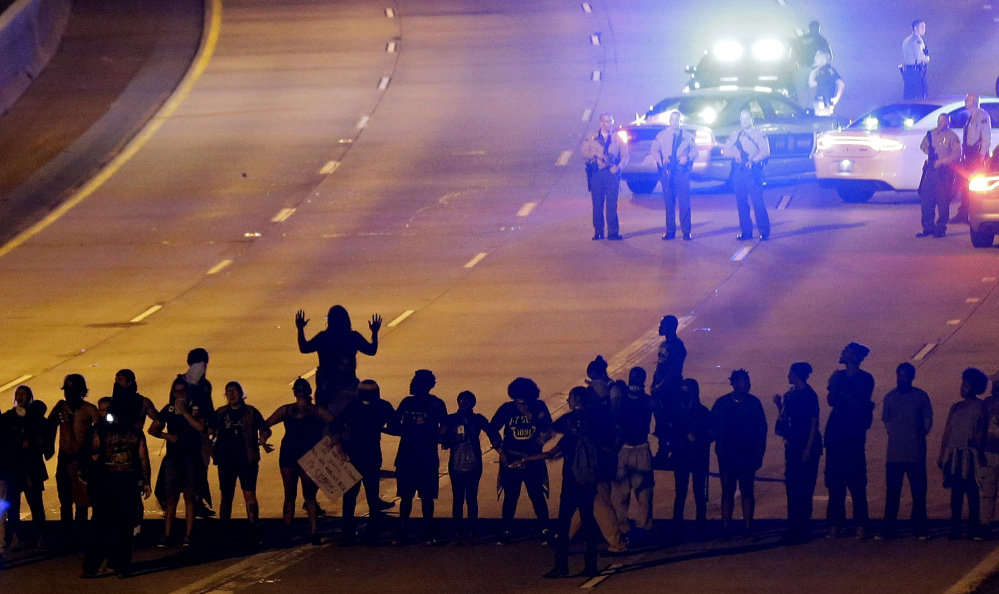CHARLOTTE, N.C. — Protests continued for a third night and a curfew was ordered here in a city reeling from a deadly police shooting that has triggered intense, violent demonstrations.
Mayor Jennifer Roberts signed an order imposing a curfew from midnight to 6 a.m. as protesters marched through the streets here Thursday, their numbers smaller than on previous nights. Some carried signs; others had bandannas to cover their faces. They chanted, “No justice! No peace!”
Charlotte Police Chief Kerr Putney said Thursday officials had no plans to release video of the shooting, despite calls from civic leaders for more transparency.
A crowd of protesters left a Charlotte park on Thursday evening and wound through the city’s streets as officers with bikes looked on.
Release the tape!” They chanted. “Release the tape!”
Authorities facing some of the most intense reactions seen in more than two years of protests over policing nationwide vowed a strong law enforcement response to the unrest, declaring a state of emergency after two nights of chaos on the streets here. National Guard Humvees rumbled down streets still littered with broken glass Thursday, passing through areas where businesses remained closed and many people stayed home because of the chaos.
Protesters here were peaceful early Thursday night but, as the night went on, they grew tense as police in riot gear blocked roads as the crowds grew restive. Around 9:15 p.m., protesters clambered up the steps of the Charlotte Mecklenburg Government Center. They were met by a line of National Guardsmen standing in front of the buildings glass doors. After protesters shouted harsh words at the guardsmen they kept moving toward the police department, where they took to the steps and shouted, “give us the tapes.”
At one point protesters outside the Mecklenburg County Jail chanted, “No justice no peace.” Inmates flicked the lights and waved as the crowd yelled, “set our brothers free!”
Around 10:25 p.m. several dozen demonstrators poured onto Interstate 277, some chanting, others sitting in the roadway and others locking arms in a chain.
The demonstration halted traffic, closing the thoroughfare in both directions. Within 10 minutes, teams of officers in riot gear converged on the demonstrators, firing pepper balls – paintball like projectiles full of a stinging substance. The crowd scattered up the grassy hills on either side of the freeway. While several demonstrators appear injured, it was unclear if any were arrested.
Later, about a half-hour before the police were to enforce the midnight curfew, about 200 protesters were headed to police headquarters, with helicopters circling overhead, shining a spotlight on the crowd. Sheriff’s deputies were stationed outside the police station.
Charlotte City Council member Al Austin said the curfew gives police the authority to make arrests. Authorities said the curfew will continue until the state of emergency is lifted or Roberts decides to rescind the curfew.
“It gives the authority, that doesn’t mean we have to do it. We’re hoping people disperse,” Austin said.
PROTESTER SHOT WEDNESDAY DIES
Bank of America is closing its Uptown Charlotte headquarters for a second day Friday in the wake of the protests.
With little information about the shooting forthcoming, questions persisted in the South’s second-largest city, which has more than 827,000 residents, a third of whom are black. Police said that they had made 44 arrests as of Thursday; one protester who was critically injured during a clash between protesters and police on Wednesday night has died, according to Charlotte police. In a statement, officials said that detectives are investigating the death of 26-year-old Justin Carr, but they did not say who shot him or if there were any suspects.
As demonstrators moved toward the Omni hotel, near where Carr was shot Wednesday, the crowd chanted his name.
Charlotte police have said Keith Lamont Scott, the man killed by police, posed “an imminent deadly threat” and refused commands to drop a weapon. Scott’s relatives have said he was reading a book and was unarmed when he encountered the black plainclothes Charlotte officer who fatally shot him on Tuesday. Officials say they found a gun, but not a book, at the shooting scene.
The State Bureau of Investigation has taken over the investigation into the shooting, authorities said Thursday.
Other officers at the scene were wearing body cameras at the time, though the officer who shot Scott – Brentley Vinson, who was placed on paid administrative leave – was not wearing any recording device.
POLICE CHIEF: NO PLAN TO RELEASE VIDEO
Kerr Putney, the Charlotte-Mecklenburg police chief, said that video footage of the encounter did not give “absolute definitive visual evidence that would confirm that a person is pointing a gun,” but he said that the footage and other evidence “supports what we’ve heard” about what happened.
Putney later told CNN that the video was not from an angle that would show a gun in Scott’s hand, but he said witnesses saw a gun and one was found nearby. However, he said the department has no imminent plans to let the public view this footage and make a determination.
“You shouldn’t expect it to be released,” Putney said during a news briefing Thursday. He added: “Transparency is in the eye of the beholder. .. If you think I’m saying we should display a victim’s worst day for public consumption, that is not the transparency I’m speaking of.”
Corine Mack, head of the Charlotte chapter of the NAACP, said she didn’t think a bigger law enforcement presence on Thursday would solve anything.
“More police presence is never going to help,” said Mack, who wants the video released. “More cops does not help. More transparency helps. More communication helps.”
Mack said that there had been “nothing but love in the air” before police turned up in riot gear. “A police officer’s job is to de-escalate the problem,” she said.
FAMILY HAS ‘MORE QUESTIONS THAN ANSWERS’
Scott’s relatives, who asked authorities to show them video of the shooting, watched it on Thursday, attorneys for the family said. In a statement, one of the family’s attorneys, Justin Bamberg, said that they watched two videos captured by police cameras and have “more questions than answers.”
According to Bamberg, the videos show Scott calmly leaving his car when asked to do so by police and not raising his hands or acting aggressive. Bamberg also said the videos do not show if Scott has anything in his hands, which he said were at his side when he was shot, the footage showed.
Scott’s family called on police to release the videos “as a matter of the greater good and transparency,” and called on people to protest peacefully.
Bamberg had said at a news conference earlier in the day that Scott’s wife, Rakeyia Scott, witnessed the shooting. “It’s my understanding that his wife saw him get shot and killed,” Bamberg said. “That’s something that she will never, ever forget.”
Scott, who had been married for two decades and had seven children, had a disability from injuries sustained in an accident, Bamberg said. He said that there were different descriptions of the shooting, including some people who say Scott was holding a book and others who said his hands were empty.
ARGUMENT OVER EVIDENCE
Footage of the encounter could help settle the dispute over whether Scott was armed, and many activists who have protested how police use force have argued that video evidence is the only way to know for sure what happened during an incident.
Police would release the video only when they find “a compelling reason,” Putney said, adding that he believed footage would do little to calm the anger.
“I can tell you this: There’s your truth, my truth and the truth,” Putney said. “Some people have already made up their minds.”
Scott is one of at least 707 people shot and killed by police so far this year and the fourth person shot and killed by a Charlotte-Mecklenburg police officer, according to a Washington Post database tracking such deaths.
His death comes on the heels of a fatal police shooting in Tulsa, and another in Columbus that killed a 13-year-old last week. This has helped push the heated debate over how police use deadly force again to the forefront of American culture. On Thursday, Officer Betty Shelby, who shot and killed 40-year-old Terence Crutcher in Tulsa last week, was charged with first-degree manslaughter.
ISSUE IN PRESIDENTIAL RACE
Speaking this week, Hillary Clinton, the Democratic presidential nominee, said that the deaths of black people at the hands of police is “unbearable, and it needs to become intolerable.” On Thursday, Donald Trump, her Republican opponent, bemoaned the unrest in Charlotte and said he felt drugs were a “very, very big factor” in the violence.
Also Thursday, Clinton called Roberts and Rep. Alma Adams, D-North Carolina, to discuss the shooting and protests and to offer any assistance during this difficult time, her campaign said in a statement.
Members of the Congressional Black Caucus delivered a letter to Attorney General Loretta Lynch on Thursday demanding “an end to what appears to be the targeting and profiling of black people that result in their deaths” and calling on the Justice Department to do more to stop police shootings.
“I know that these are difficult times,” Lynch, a North Carolina native, said during a news conference Thursday. “I know that the events of recent days are painfully unclear and they call out for answers. But I also know that the answer will not be found in the violence of recent days.”
Lynch again called for peaceful demonstrations, saying that those engaging in violence are “drowning out the voices of commitment and change and ushering in more tragedy and grief in our communities.”
The FBI and Justice Department are monitoring the situation involving Scott’s death, Lynch said, but federal officials have not launched their own investigation.
Late Wednesday, Gov. Pat McCrory, a former mayor of Charlotte, signed an order declaring an emergency due to “civil disturbances” and a need to protect people and businesses “from violence and danger.” His order will remain in effect until he rescinds it.
He also deployed the North Carolina National Guard – which said Thursday that it was postponing its scheduled ball given “unforeseen circumstances” in the state – as well as the State Highway Patrol, which he said was in response to a request from Putney.
McCrory’s office posted photos online Thursday showing him visiting with two Charlotte police officers he said were injured by protesters.
PROTESTER’S FATAL INJURIES IN DISPUTE
Confusion still swirled around the violence Wednesday night, during which city officials reported – and then retracted – that a demonstrator was killed in what they called a “civilian on civilian” shooting. Police later said the person was in critical condition.
However, protesters said that demonstrator was struck by police, which officials have denied. Putney said investigators are reviewing video to determine who shot the man, noting that there are claims a police officer “was involved.”
A man who identified himself as Jimmy James Tyson, who said he was a street medic – an activist serving as a first responder for protesters – said that he thinks the demonstrator was struck with a rubber bullet. Tyson said that the demonstration was unruly but not violent until riot police arrived and “at that moment, the entire tone and energy of the protest shifted.”
City workers repaired windows at the Ritz-Carlton Hotel in uptown Charlotte and at a nearby Bank of America building Thursday. Some people milled about on the streets, but far fewer than would be out on a normal weekday with pleasant temperatures in the 70s.
“I was very worried about coming into work today, because I didn’t know how our building was going to look,” said Anthony Martin, 23, lives and works in Charlotte.
The NFL said Thursday that it was “monitoring events in Charlotte” but was still planning to have the Carolina Panthers host the Minnesota Vikings for a game Sunday.
Antonia Arnold, who has lived in Charlotte for three years, said “a lot of people are scared” of the violence.
“Charlotte’s not really like this,” said Arnold, 20, a student at Johnson & Wales University in Charlotte. There’s obviously a divide . . . but there’s never any conflict, really. And now all of a sudden, even with the peaceful protests, it just escalated.”
Send questions/comments to the editors.





Comments are no longer available on this story